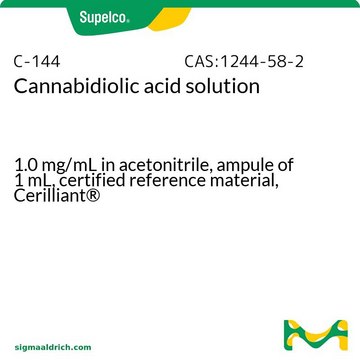C-144S
Cannabidiolic acid solution
1 mg/mL in acetonitrile, certified reference material, ampule of 1 mL, Cerilliant®
About This Item
Polecane produkty
klasa czystości
certified reference material
Poziom jakości
Właściwości
Snap-N-Spike®/Snap-N-Shoot®
opakowanie
ampule of 1 mL
producent / nazwa handlowa
Cerilliant®
stężenie
1 mg/mL in acetonitrile
format
single component solution
temp. przechowywania
−70°C
InChI
1S/C22H30O4/c1-5-6-7-8-15-12-18(23)20(21(24)19(15)22(25)26)17-11-14(4)9-10-16(17)13(2)3/h11-12,16-17,23-24H,2,5-10H2,1,3-4H3,(H,25,26)/t16-,17+/m0/s1
Klucz InChI
WVOLTBSCXRRQFR-DLBZAZTESA-N
Szukasz podobnych produktów? Odwiedź Przewodnik dotyczący porównywania produktów
Opis ogólny
Cannabidiolic acid (CBDA) is one of the main cannabinoids found in plants of the Cannabaceae family, such as hemp and cannabis. It occurs mostly in the leaves of the plant and on decarboxylation in the presence of light or heat forms cannabidiol (CBD). It is known to show anxiolytic, anti-inflammatory, anti-hyperalgesic, antiemetic, neuroprotective, and anticonvulsant activities.
Zastosowanie
- Determination of four cannabinoids from an oil matrix using reversed-phase high-performance liquid chromatography (RP-HPLC) combined with a diode array detector (DAD)
- Analysis of hemp seed oil samples for identification and estimation of seven major cannabinoids by HPLC coupled to a UV detector
- Separation and determination of CBD and CBDA from hemp oil samples using liquid-liquid extraction and HPLC-DAD
- Multi-analysis of 11 cannabinoids in biomass and extracts of different cannabis varieties by an HPLC-UV method, following the International Conference on Harmonization (ICH) Tripartite Guideline for Validation of Analytical Procedures
- Development and validation of an HPLC-DAD method for the simultaneous analysis of five major neutral and acidic cannabinoids in cannabis and hashish samples
- Gas chromatography-mass spectrometry (GC-MS) analysis of ten main cannabinoids from hemp inflorescences following their silylation and esterification for derivatization
Cechy i korzyści
- Fully characterized under ISO/IEC 17025 and ISO 17034 accreditation
- Accompanied with a comprehensive Certificate of Analysis (CoA) with data on stability, homogeneity, accuracy of concentration, uncertainty, and traceability
- Rigorously tested through real-time stability studies to ensure accuracy and shelf life
- Gravimetrically prepared using qualified precision balances to ensure minimal uncertainty
- Flame sealed under argon into ampoules for long-term shelf life
- Offered in a convenient, DEA-exempt format to improve laboratory efficiency
Informacje prawne
produkt powiązany
Hasło ostrzegawcze
Danger
Zwroty wskazujące rodzaj zagrożenia
Zwroty wskazujące środki ostrożności
Klasyfikacja zagrożeń
Acute Tox. 4 Dermal - Acute Tox. 4 Inhalation - Acute Tox. 4 Oral - Eye Irrit. 2 - Flam. Liq. 2
Kod klasy składowania
3 - Flammable liquids
Klasa zagrożenia wodnego (WGK)
WGK 2
Temperatura zapłonu (°F)
35.6 °F - closed cup
Temperatura zapłonu (°C)
2.0 °C - closed cup
Certyfikaty analizy (CoA)
Poszukaj Certyfikaty analizy (CoA), wpisując numer partii/serii produktów. Numery serii i partii można znaleźć na etykiecie produktu po słowach „seria” lub „partia”.
Masz już ten produkt?
Dokumenty związane z niedawno zakupionymi produktami zostały zamieszczone w Bibliotece dokumentów.
Nasz zespół naukowców ma doświadczenie we wszystkich obszarach badań, w tym w naukach przyrodniczych, materiałoznawstwie, syntezie chemicznej, chromatografii, analityce i wielu innych dziedzinach.
Skontaktuj się z zespołem ds. pomocy technicznej





